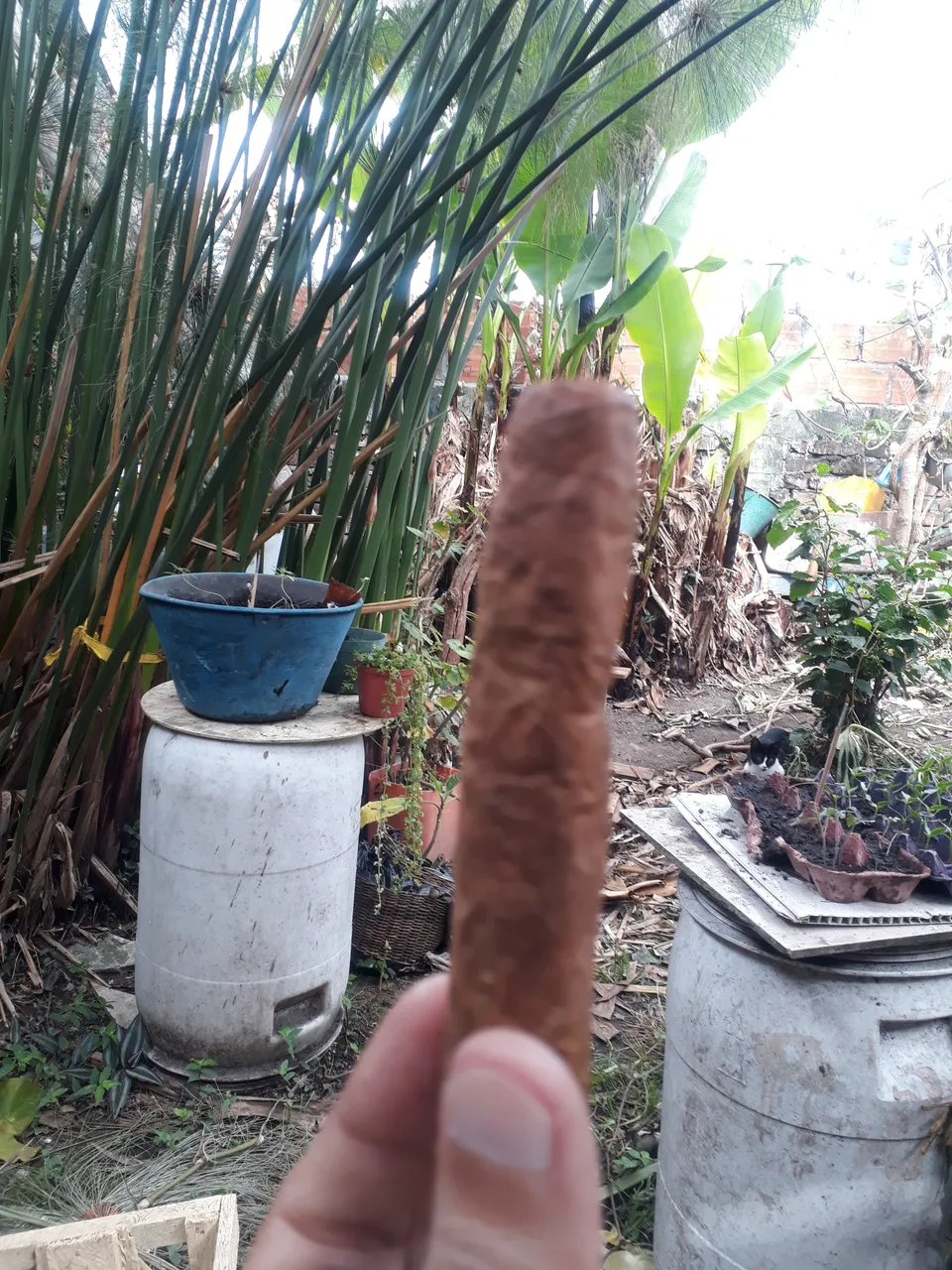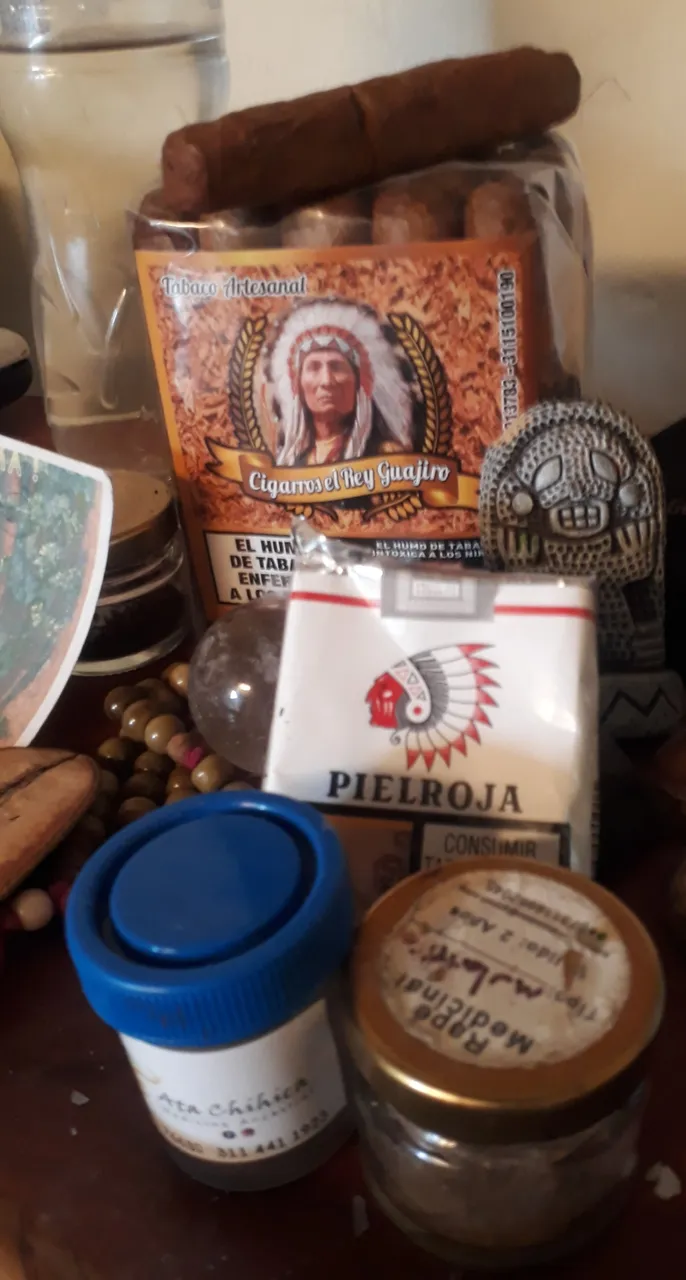Grandfather Tobbaco,
my oldest plant teacher,
my friend and ally.
my oldest plant teacher,
my friend and ally.
For some, it's a poison, a way to forget.
For me, its use is sacred, ritual. Tobbaco is a holy prayer.

Before writing this post, I prepared a ritual.
First I set my intention: to write the truth, to open a sacred space, to be the voice for a little while of Grandfather Tobacco.
I lit some palosanto to harmonize and clean the house, I prepared the rapé and the tobacco I was going to use on the prayer.
@neyxirncn saw me preparing and offered to join the prayer, so we cleaned each other with the palosanto and went to the patio to bless the tobacco.
Then we lit it and proceeded to smoke it in turns, in silence, total concentration...


Tobacco is a mainstay of every originary culture of America.
It is smoked, aspired, drank, used as paste and even as protection of the spaces.
From the peace pipe of North America to the Mapacho cigarettes of the South, passing through all the rapé snuffs of the Amazon, Grandfather Tobacco is present in every sacred ritual of the cultures of America.
It is the plant of silence, of instrospection, of concentration.
The full effect of Grandfather Tobbaco is hard on the body. You get cold sweats, you get weak, you get dizzy and for sure you might puke. But all that sacrifice pays off with the mental clarity Grandfather Tobacco gives, cleansing the body and making us puke bad emotions.
I have been trained by the Amazon curanderos to clean myself and, by extension, other by blowing the sacred tobbaco smoke with intention.
Tobacco smoke is to be held in the mouth, not inhaled to the lungs. Such is the first lesson one learns with the curanderos. Then you have to be totally concentrated and 100% in the present moment, and then you put all you powerful intention in the smoke:
"Tobacco to connect with my inner silence.
Tobacco to listen to my intuition.
Tobacco, clean my mind. Tobacco, guide my hearth."

We finished the tobacco prayer in the patio.
I'm already feeling the medicine effect; I'm a little dizzy. I then ask Ney to blow some Tikuna Rapé from Colombia.
I concentrate. I charge the applicator with half the charge and hand it to Ney. She puts her prayer into it and blows all the snuff gently into my nose.
BOOM, my eyes water,I sneeze and hold a gag.
There is still half of it to go.
I take the applicator and charge what was left on it, then Ney proceeds to blow it in my other nostril.
TOTAL SILENCE.
I spit a lot of saliva, I cry some more, a lot of mucus comes out, I stay concentrated. The clarity comes, I'm totally calm. Its done. I collect myself, clean the space and put back the sacred medicines in the altar.
I won't go into detail about Rapé snuff, my friend @auelitairene has an amazing post about rapé snuff you should check out.

Here in Colombia, you find two traditional uses of tobacco paste:
CHIMÓ a paste used mostly in the flats. It's made using mineral salts from lakes.
@trovadormusica is a fan of Chimó and has an in-depth article about Chimó and its history. .

And AMBIL, another tobacco paste usually accompanied by Mambe (coca leaves flour).

For me , tobacco it's part of my Yopo ritual, as I have been shown by my friend and teacher Rufino Pónare, Menheruha of the Huottuja people of the Amazon.
And so it has been for hundreds and maybe thousands of years in the jungle.

During my week I usually consecrate one "Piel Roja" no filter cigarette.
During ceremonies, we smoke a lot. It happens that tobacco is synergistic with IMAOs from the Caapi and, overall, potentiates the Yopo ritual by a great deal. During Yopo ceremonies one can smoke all the cigarettes and tobaccos one feels like.
For some people, that amount of tobacco might seem like a bad idea. But the shamans are among the healthiest people I know, if not the healthiest as I group.
The intention, the ritual and the medicines make this massive occasional use one of healing, not of abuse.
Same as me, Rufino smokes very little outside the ceremonies.

Grandfather Tobacco is a strict teacher and punish very harshly those who abuse it.
I won't go into detail, but it's clear that our modern cigarettes with their filters, solvents so they stay lit, artificial flavors to mask or modify the smell and flavor, are a far cry from the sacred medicine of the jungle. And we pay for that with sickness and addiction.
So that has been said.

Finally, I introduce you to the most beautiful gift life has given me.
Meet Sayri Santiago:

Sayri means in Quechua: Prince, who help those who ask him. And GRANDFATHER TOBACCO.
He has the name of the plant of truth, honesty, silence and strength.
My son is blessed by one of the older plant teachers of human history, and he will learn through example how plant medicine is used so he can decide about his health, not with only info but with the prayers and songs of his ancestors.
ADIWA HATTÉ

NARRACIÓN EN ESPAÑOL:
Abuelo Tabaco,
mi planta maestra más antígua,
mi amigo y aliado.
mi planta maestra más antígua,
mi amigo y aliado.
Para algunos, es un veneno. Una manera de olvidar.
Para mí, su uso es sagrado, ritual. El tabaco es una plegaria sagrada.

Antes de escribir esta entrada, preparé un ritual.
Primero, puse mi intención: escribir la verdad, abrir un espacio sagrado de comunicación, ser la voz, por un momento, del Abuelo Tabaco.
Prendí algo de Palosanto para armonizar y limpiar la casa. Preparé el Rapé y el tabaco que usaría en el rezo.
@neyxirncn me vio preparándome y ofreció unirse al rezo, así que nos limpiamos con palosanto y nos fuimos al patio a rezar el tabaco.
Allí procedimos a encenderlo y a fumarlo por turnos, en silencio, total concentración...


El tabaco esta presente en todas las culturas originarias de América.
Es fumado, aspirado, tomado, usado como pasta y hasta como protector de espacios.
Desde la pipa de la paz de Norteamérica a los cigarros Mapachos del Sur, pasando por los polvos Rapé del Amazonas, el Abuelo Tabaco está presente en todos lor rituales sagrados del las culturas de América.
Es una planta de silencio, introspección de concentración.
El efecto ritual completo del Abuelo Tabaco es fuerte en el cuerpo. Sudas frío, te sientes débil y, casi seguro, vomitas. Pero todo ese sacrificio paga con la claridad mental que el Abuelo Tabaco da, limpiando el cuerpo y haciéndonos vomitar las malas emociones.
He sido entrenado por los curanderos amazónicos para limpiarme y, por extensión, a los demás soplando el sagrado humo del tabaco usando la intención.
El humo del tabaco se debe mantener en la boca, no se lleva a los pulmones. Esa es la primera lección que uno aprende con los curanderos. Hay que estar concentrados y 100% en el momento presente. Y, allí, se le pone la intención total de limpiar el cuerpo y el espíritu:
Tabaco para escuchar mi intuición.
Tabaco limpia mi mente, tabaco guía mi corazón."

Finalizamos el rezo del tabaco en el patio.
Ya siento los efectos de la medicina, estoy un poco mareado. Entonces, le pido a Ney que me sople ago de Rapé Tikuna de Colombia.
Me concentro, cargo el aplicador con la mitad de la carga y lo paso a Ney. Ella pone su rezo y me sopla gentilmente el tabaco en el orificio derecho.
BOOM, se me agüan los ojos, estornudo y aguanto una arcada.
Todavía falta la mitad.
Tomo el plicador y cargo la otra mitad y Ney procede a soplarme en el otro orificio.
SILENCIO TOTAL.
Escupo bastante saliva, lloro un poco, saco un montón de moco, me mantengo concentrado. Viene la claridad, estoy totalmente calmado. Esta hecho. Me arreglo, limpio el espacio y devuelvo las medicinas sagrada al altar.
No entraré en detalles acerca del Rapé. Mi amiga @auelitairene tiene una entrada genial sobre el rapé que deberían chequear.

Acá en Colombia, encuentras un par de usos tradicionales de la pasta de tabaco:
El CHIMÓ se usa mayoritariamente en los llanos. Es extraído usando sales minerales de los lagos.
@trovadormusica es un fan del Chimó y tiene un artículo bien detallado del CHIMÓ y su historia.

El otro es el AMBIL, pasta de tabaco usada en general con el Mambe (harina de hojas de coca).

Para mí, el tabaco es parte de mi ritual de Yopo, como he sido enseñado por mi amigo y maestro Rufino Pónare, Menherua del pueblo Huotujja del Amazonas Venezolano.
Así ha sido por cientos, quizás miles de años en la selva.

Durante mi semana, usualemnte fumo un cigarrillo "Piel Roja" al día.
Pero eso cambia durante las ceremonias, donde se fuma bastante.
Resulta que el tabaco es sinérgico con los efectos de los IMAOs del Caapi y potencia bastante los efectos del ritual de Yopo. Durante la ceremonia de Yopo uno puede fumar tabacos y cigarrrilos como así desee.
Para mucha gente, esa cantidad de tabaco puede ser una mala idea. Pero los Chamanes están entre la gente más sana que conozco, quizás los más sanos como grupo.
La intención, el ritual y las otras medicinas hacen de este uso masivo ocasional uno de sanación, no de abuso.
Como yo, Rufino fuma poco fuera de las ceremonias.

El abuelo Tabaco es un maestro estricto y castiga duramente a aquellos que abusan de él.
No entraré en detalles, pero está claro que nuestros cigarrillos modernos con sus filtros, solventes para que no se apaguen y sus sabores artificiales para enmascarar o cambiar el sabor y olor están bien lejos de la sagrada medicina de la selva. Y eso lo pagamos con enfermedad y adicción.
Cada medicina es veneno si se usa de manera incorrecta y sin intención, solo compulsión.
Y así lo manifiesto.

Finalmente, les presento el regalo más bonito que me ha dado la vida.
Conozcan a Sayri Santiago:

Sayri significa en Quechua: "Príncipe que ayuda a quien se lo solicita."
Y ABUELO TABACO.
Lleva el nombre de la planta de la verdad, honestidad, silencio y fortaleza.
Mi hijo está bendecido por una de las plantas maestras más antíguas conocidas por la humanidad. Y aprenderá a través del ejemplo cómo se usa la medicina de plantas, para que él decida sobre su salud.
Y así en humo elevo este rezo para que todos respetemos y así seamos benditos por nuestras medicinas elegidas.
ADIWA HATTE.

